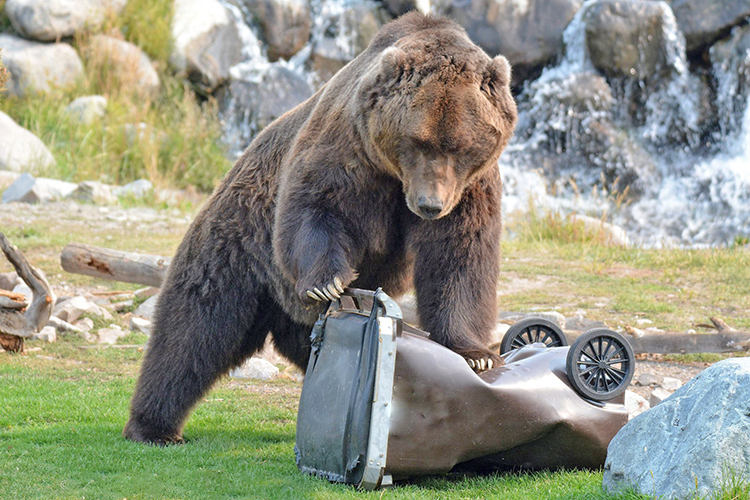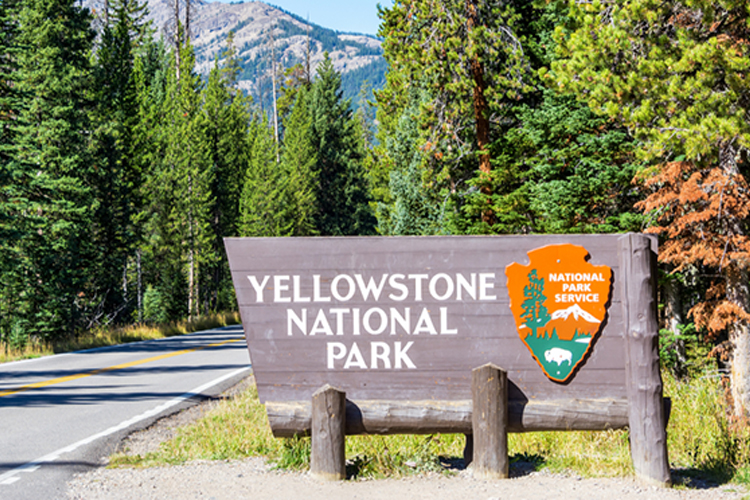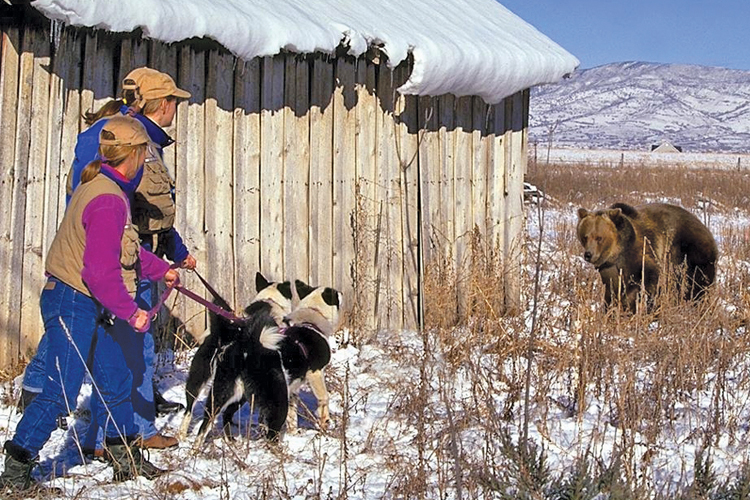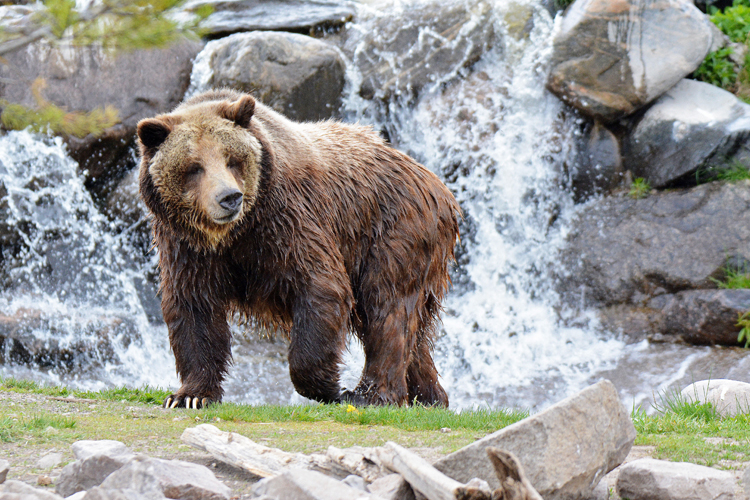CONSERVATION
The GWDC has played an integral role in a wide range of conservation efforts
The GWDC staff is dedicated to conservation through: working to improve the lives of the animals in our care, inspiring personal connections through education and by helping to protect species, wildlife, human communities and the habitats we all share.
By supporting and conducting critical conservation projects and practices, and emboldening and motivating thousands of visitors, our efforts help insure these magnificent species will be protected for future generations.
PARTNER SPONSORSHIPS...

_______________________________________________
Interagency Grizzly Bear Committee (IGBC)
Container Testing
In keeping with our continuing effort to educate the public on living and traveling safely in bear country, the GWDC cooperates with state and federal agencies in the testing of bear-resistant food and garbage storage containers.
At this time GWDC is the only facility approved for testing products for the IGBC bear-resistant products testing program. This testing protocol allows consumers, parks and municipalities to obtain products that have been certified as being bear resistant.

__________________________________________
Yellowstone National Park
Wildlife Restoration Foundation (WRF) partners accredited zoos and aquariums with National Parks, National Forests, and National Marine Sanctuaries to generate their capacity to repopulate and improve wildlife health and security through Collaborative Field Conservation, Park Zoo Portals, and Community Stewardship.
The "I Am Bear Safe" Project is a product of partnering the Grizzly & Wolf Discovery Center and Yellowstone National Park Zoo Park Partnership (ZPP) with the Custer Gallatin National Forest and small towns bordering the park. WRF works with Park Gateway Partners to customize and use tools that train tourists and recreationists to prevent wildlife displacement and habituation to humans that results in conflict.
![]()

_________________________________________
Montana State University
The Golden Eagle Lure bird, a long-standing project that assesses bald and golden eagle lead poisoning and habitat encroachment. One of the golden eagles cared for and exhibited at the GWDC is regularly transported to various study sites and serves as a “lure” for bird for capturing dozens of wild eagles for critical eagle research work with other agencies including MSU. The eagle studies have been documented in peer-review journals and publications.

__________________________________________
Wind River Bear Institute
Since its inception in 1995 the Wind River Bear Institute (WRBI) has been changing the way bear managers work with food-conditioned bears. The ultimate goal of the program is the coexistence of humans and bears by preventing and reducing conflicts.
WRBI use Karelian Bear Dogs that have proven to be a perfect partner for wildlife managers and ambassadors for educating the public about “Bear Shepherding”. A conditioning process that simultaneously teaches humans to prevent conflicts and teaches problem bears behaviorally based lessons that create boundary awareness and avoidance of human-occupied space.
The GWDC has worked with the WRBI since 2003 when our first Karelian Bear Dog "Jewel" was adopted as the newest member of the education staff. A program was developed to introduce and educate visitors about how valuable these animals can be in decreasing conflicts with bears.

______________________________________
Advanced Conservation through Empathy (ACE)
Advancing Conservation through Empathy (ACE) for Wildlife is a northwestern region-specific group within AZA that is focused on sharing and developing best practices in wildlife and conservation education at zoos between member organizations using education and communication practices that are supported by the best available science. The group also seeks to expand the use of formal research tools to assess outcomes like visitor engagement and impact across member organizations. The GWDC has been a member of ACE since 2021.

_____________________________________________
Taxonomic Advisory Groups (TAGs)
TAGs are groups within AZA that are focused on developing and sharing guidance on population management for a particular species across AZA organizations. They oversee and organize the SSP (Species Survival Plan) breeding programs for each species, and they develop a repository of species-specific knowledge about care and wellness needs as well as common management practices from member organizations. GWDC conservation staff is actively involved with several relevant TAGs groups.
EDUCATION & OUTREACH...
The GWDC staff works closely with undergraduate and graduate students enabling students to gain the skills required to execute scientific research with wild animals, as they work towards careers in veterinary science, ecology, or wildlife conservation.
We have worked closely with the National Park Service regarding their conservation efforts educating the public about the proper use and effectiveness of Bear Pepper Spray. The hope is that increasing people’s understanding about Bear Pepper Spray will prevent future conflicts.
We are active participants in several local community conservation efforts including International Migratory Bird Day, Earth Day, Raptor Fest, the Audubon Society’s Christmas Bird Count.
RESEARCH...
Assisted the US Geological Survey (USGS) in their efforts to better understand mange, a parasitic disease that causes animals to lose their fur.
Researchers from the Wind River Bear Institute endeavoring to learn if bears use low-frequency calls to communicate with each other, as elephants do, ran a series of tests at the GWDC.
A research study was conducted to study the benefits of wolf kills to other Yellowstone wildlife using the Center's bears to determine how fast a grizzly can consume meat.
Scat and urine from GWDC bears and wolves were used by a University of Nevada biologist studying moose vulnerability to predators in Jackson Hole.
Scat from the Center's wolves was used by Yellowstone National Park's wolf project to test the accuracy of the lab used to analyze wild scat samples from Yellowstone.
A USGS bear researcher used GWDC bears to evaluate the effectiveness of different lures. The most effective lure was later used in a large study in northwestern Montana which snagged bear hair for DNA analysis and population estimation and the effect of sample age on DNA analysis success.
GREEN PRACTICES...
For more than 20 years we have been committed to natural resource conservation as a way to maintain natural ecosystems and prevent environmental degradation. Composting and recycling for both staff and visitors has become a central part of our culture. We have instituted monitoring energy use, installed LED lighting and host several Electric Vehicle charging stations - the first partnership of its kind in the West Yellowstone.

Throughout the year, volunteers and staff participate in trash clean-ups around around West Yellowstone.
Essential components of our sustainability planning are using resources responsibly and to plan thoughtfully for future infrastructure upgrades.




